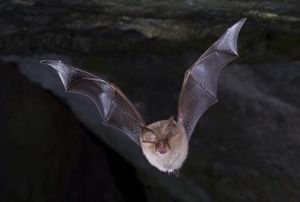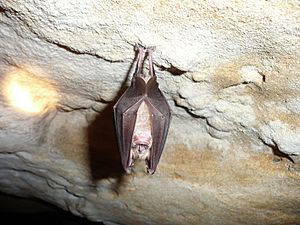Old Bow and Old Ham Mines facts for kids
| Site of Special Scientific Interest | |
| Area of Search | Gloucestershire |
|---|---|
| Coordinates | 51°46′36″N 2°36′39″W / 51.776729°N 2.610882°W |
| Interest | Biological |
| Area | 40.3 hectare |
| Notification | 1998 |
The Old Bow And Old Ham Mines are a very special place for nature in Gloucestershire, England. This area, which is about 40 football fields big (40.3 hectares), was named a Site of Special Scientific Interest (SSSI) in 1998. This means it's protected because of its important wildlife, especially its bats!
Contents
A Home for Bats
The Old Bow And Old Ham Mines are part of a group of important natural sites in the Forest of Dean and Wye Valley. These places are super important for bats, especially for two types: the lesser horseshoe bat and the greater horseshoe bat. These mines are like a five-star hotel for bats, giving them safe places to live and sleep during winter. This makes the area important for bats all over Europe!
The mines are old tunnels dug into Limestone rock to find iron ore. These underground tunnels are perfect for bats because they stay cool and damp, which is just what bats need to hibernate. The Old Bow and Old Ham mines have a huge network of tunnels, stretching for about 30 kilometers (that's like walking for miles underground!). They are located near a village called Clearwell.
The area around the mines is also great for bats. The Forest of Dean and the Wye Valley have lots of leafy woodlands and sheltered valleys. These areas are perfect hunting grounds for bats to find insects to eat.
Bat Species Living Here
While many different bats use the mines, the site is mostly famous for its lesser horseshoe bats. More than 300 of these bats regularly use the mines! A smaller number of greater horseshoe bats also live here.
Other types of bats that have been found hibernating in the mines include:
- Daubenton's bat
- Brandt's bat
- Natterer's bat
- whiskered bat
- long-eared bat
Horseshoe bats spend their winters sleeping in the caves and tunnels. They can move around different parts of the mines in spring and autumn to find just the right temperature and humidity. The large size and depth of these mines make them an ideal spot for bats to find a cozy place to sleep.
Clearwell Caves: A Part of the Mines
Part of this amazing underground system is known as the Clearwell Caves. These caves are open to visitors and are famous for their beautiful rock formations. You can see sparkling stalactites and amazing crystals made of minerals like haematite, dolomite, and calcite. People also still dig for natural pigments like ochre here, which are used to make paints, and sometimes even small amounts of iron ore.
Images for kids








